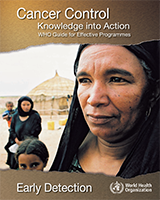All rights reserved. Publications of the World Health Organization can be obtained from WHO Press, World Health Organization, 20 Avenue Appia, 1211 Geneva 27, Switzerland (tel.: +41 22 791 3264; fax: +41 22 791 4857; e-mail: tni.ohw@sredrokoob). Requests for permission to reproduce or translate WHO publications – whether for sale or for noncommercial distribution – should be addressed to WHO Press, at the above address (fax: +41 22 791 4806; e-mail: tni.ohw@snoissimrep).
NCBI Bookshelf. A service of the National Library of Medicine, National Institutes of Health.
The World Health Organization estimates that 7.6 million people died of cancer in 2005 and 84 million people will die in the next 10 years if action is not taken.
More than 70% of all cancer deaths occur in low and middle income countries, where resources available for prevention, diagnosis and treatment of cancer are limited or nonexistent.
Yet cancer is to a large extent avoidable. Over 40% of all cancers can be prevented. Some of the most common cancers are curable if detected early and treated. Even with late cancer, the suffering of patients can be relieved with good palliative care.
Cancer control: knowledge into action: WHO guide for effective programmes is a series of six modules offering guidance on all important aspects of effective cancer control planning and implementation.
This module addresses specific aspects of cancer early detection. It discusses how to develop a plan and programme that effectively respond to the needs of patients with an early or detectable cancer. This module is based on the Planning module, which provides a comprehensive understanding of the cancer control planning process and its main steps.
Contents
- INTRODUCTION TO THE CANCER CONTROL SERIES
- KEY MESSAGES
- PRE-PLANNING
- PLANNING STEP 1: Where are we now?
- PLANNING STEP 2: Where do we want to be?
- DEFINE THE TARGET POPULATION FOR EARLY DETECTION OF FREQUENT CANCERS
- IDENTIFY GAPS IN EARLY DETECTION SERVICES
- SET OBJECTIVES FOR EARLY DIAGNOSIS AND SCREENING
- ASSESS FEASIBILITY OF EARLY DETECTION INTERVENTIONS
- ADDRESS ETHICAL ASPECTS
- SET PRIORITIES FOR EARLY DETECTION
- CHOOSING BETWEEN EARLY DIAGNOSIS AND SCREENING
- PLANNING STEP 3: How do we get there?
- CONCLUSION
- REFERENCES
- ACKNOWLEDGEMENTS
The production of this publication was made possible through the generous financial support of the National Cancer Institute (NCI), USA, and the National Cancer Institute (INCa), France. We would also like to thank the Public Health Agency of Canada (PHAC), the National Cancer Center (NCC) of the Republic of Korea, the International Atomic Energy Agency (IAEA) and the International Union Against Cancer (UICC) for their financial support.
The designations employed and the presentation of the material in this publication do not imply the expression of any opinion whatsoever on the part of the World Health Organization concerning the legal status of any country, territory, city or area or of its authorities, or concerning the delimitation of its frontiers or boundaries. Dotted lines on maps represent approximate border lines for which there may not yet be full agreement.
The mention of specific companies or of certain manufacturers' products does not imply that they are endorsed or recommended by the World Health Organization in preference to others of a similar nature that are not mentioned. Errors and omissions excepted, the names of proprietary products are distinguished by initial capital letters.
All reasonable precautions have been taken by the World Health Organization to verify the information contained in this publication. However, the published material is being distributed without warranty of any kind, either expressed or implied. The responsibility for the interpretation and use of the material lies with the reader. In no event shall the World Health Organization be liable for damages arising from its use.
- NLM CatalogRelated NLM Catalog Entries
- Cancer Control: Knowledge into ActionCancer Control: Knowledge into Action
Your browsing activity is empty.
Activity recording is turned off.
See more...
